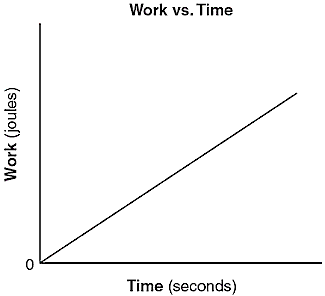Daniella Garcia-Loos
AP Physics C: Mechanics ⚙️
68 resourcesSee Units
Power and Work vs Time💡
Power is essentially the rate of change of energy/work in a system. While this key concept is quite brief, power is a topic explored not just in the realm of mechanics. Power is typically used in reference to electricity but it can refer to even the simplest scenarios like walking up the stairs. The units for power are typically Watts or Joules/seconds.
Here are the two main formulas for Power:
Here you can see above that Power can be the slope in a Work vs Time graph or an Energy vs Time graph, which may be useful for FRQs! Let's take a look at one of those graphs!

Taken from New York State Library System
Work won't always be a straight line, sometimes it may be a constant horizontal line, and it can also be negative! Just be aware that power is the slope.
It can also be simplified into the equation below:
We must remember our formula from kinematics and simplify
Here are some key takeaways about Power:
- Power is defined as the rate at which work is done or energy is transferred. Mathematically, power is represented as the derivative of work with respect to time (P = dW/dt)
- Power is also defined as the dot product of the force and velocity (P = F.v)
- The unit of power is the Joule per second (J/s) or the watt (W)
- In physics, work and power are scalar quantities and their direction is not considered.
- Power can be calculated for both conservative and non-conservative forces.
- In a conservative system, the power is zero when the object is at a position of stable equilibrium.
- In a nonconservative system, power may not be zero even when the object is at a position of stable equilibrium.
- Power can be calculated for various types of systems such as electrical, mechanical, thermodynamic, and more.
- The efficiency of a system is defined as the ratio of the output power to the input power.
- The maximum efficiency of a system is determined by the laws of thermodynamics.
- Power can be calculated for different types of systems such as electrical, mechanical, thermodynamic, and more.
- The efficiency of a system is defined as the ratio of the output power to the input power.
- The maximum efficiency of a system is determined by the laws of thermodynamics.
- In mechanical systems, power can be calculated as the product of the torque and the angular velocity (P = T.w)
- In electrical systems, power can be calculated as the product of the current and the voltage (P = I.V)
- In thermodynamic systems, power can be calculated as the product of the heat flow and the temperature difference (P = Q.ΔT)
- In case of a cyclic process the net work done is zero, thus the net power is also zero.
Practice Questions
1. A large household air conditioner may consume 15.0 kW of power. What is the cost of operating this air conditioner 3.00 h per day for 30.0 d if the cost of electricity is $0.110 per kW · h? (Taken from Lumen Learning)
Answer:
Multiply the cost of electricity per hour by the maximum consumption to find the cost per hour
$15 * 0.110 = 1.65$
Then multiply by the amount of usage per day and the amount of days
$1.65 330 = 148.5$
$149
2. Calculate the power output needed for a 950-kg car to climb a 2.00º slope at a constant 30.0 m/s while encountering wind resistance and friction totaling 600 N. (Taken from Lumen Learning)
Answer:
Browse Study Guides By Unit
🚗Unit 1 – Kinematics
🚀Unit 2 – Newton’s Laws of Motion
🎢Unit 3 – Work, Energy, & Power
🎳Unit 4 – Systems of Particles & Linear Momentum
🚲Unit 5 – Rotation
🌊Unit 6 – Oscillations
🪐Unit 7 – Gravitation
📚Study Tools

Fiveable
Resources
© 2025 Fiveable Inc. All rights reserved.